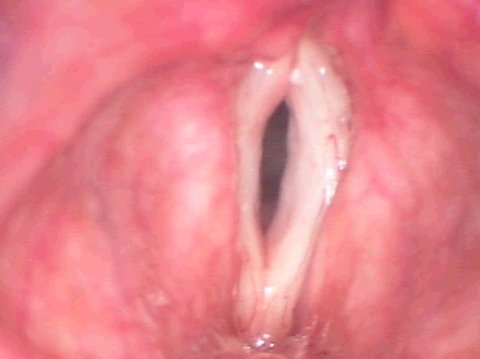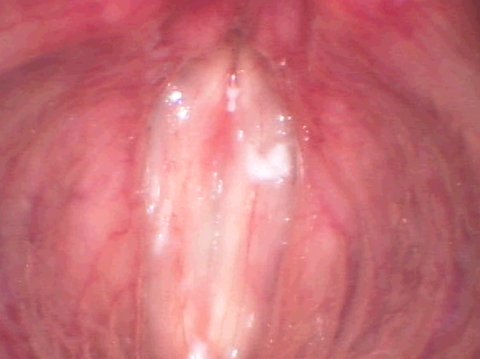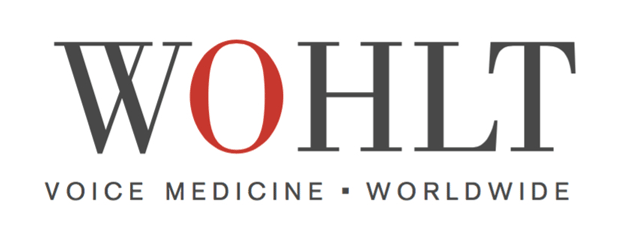When is anti-aging surgery indicated for the aging voice?
Over the course of their lifetimes, peoples’ voices change as a natural function of aging; in some people, these changes become particularly noticeable. The primary reason for this is because their vocal musculature undergoes significant atrophy. The vocal folds lose muscle mass and their ability to close completely to produce voice. The voice sounds raspy and breathy.
Even in such cases, the patients’ desire for a vibrant and resonant voice can be fulfilled.
A surgical option is available that can reinstate the ability of the vocal folds to close completely or to markedly improve vocal fold closure during phonation. This has an outstandingly positive effect on the tonal quality, the vibratory patterns of the vocal folds and the effort required to produce voice.
Vocal folds before anti-aging surgery

Vocal folds after anti-aging surgery


Dr. Wohlt’s Operative Method
The operative method used by Dr. Wohlt involves augmentation of the vocal folds with autologous fat tissue. Vocal fold augmentation, also called a voice lift is a long-established procedure. Meanwhile a number of artificial materials have become available for this indication.
Those that deserve special mention include:
- Hyaluronic acid
- Calcium hydroxylapatite
- Silicon compounds
AWhat all these substances have in common is that they consist of artificial materials that can trigger allergic reactions or even be rejected by the body as a result of inflammatory processes. Moreover, polymers released from some plastics can induce unpredictable crystallization phenomena in the tissue.
It is for these reasons that Dr. Wohlt exclusively relies on autologous fat tissue to augment atrophied vocal folds as part of his anti-aging surgery. The fat is harvested from the patient through a small skin incision near the belly button.
The advantage of using autologous fat tissue is that it cannot trigger any allergic reactions as compared to artificial products because it constitutes endogenous tissue from the patient's own body. Neither are rejection reactions to be expected for the same reason.
The primary advantage, however, lies in the soft, supple texture of the fat tissue itself. By its nature, this type of tissue is especially suited for augmenting vocal folds. For instance, it allows the surgeon to sculpt – if you wish – the external form of the vocal fold.
Moreover, the procedure can be accomplished within approx. 50-60 minutes on an outpatient basis. This technique is performed exclusively through the patient’s mouth. In other words, it is not necessary to make an external incision through the skin and laryngeal cartilage.
How is voice lift performed?
For this procedure, first, a small skin incision is made near the belly button to harvest autologous fat tissue. Afterwards, the wound is closed and the fat is processed according to specific criteria. Next, the fat is injected precisely into the atrophied vocal folds. During this process, it is particularly important to inject exactly the right amount of fat cells at the optimal sites. Too little or too much can result in less satisfactory outcomes, like significant overcorrection.
That said, it should be noted that a certain amount of overcorrection will always make sense; in other words, a little more fat must be injected than would be required for good vocal fold closure.
The reasoning behind this seeming contradiction is that the body absorbs the liquid portions of fat during the first postinterventional weeks. Therefore, a certain amount of reserve autologous fat above and beyond the minimum amount should always be injected into the vocal folds.
After surgery, the patient can expect to delight in their much more sonorous and stronger voice. The immediate improvement in voice is indeed often highly impressive. A postoperative period of vocal rest is not needed.
Voice Lift (fat augmentation) in a male patient
Vocal folds before voice lift
Vocal folds after voice lift

What happens during the postoperative phase?
As mentioned above, the patient does not need to maintain voice rest after anti-aging surgery (fat augmentation). The only wound that needs to heal is at the injection sites, little holes from the injection but these close up relatively fast.
After a brief period, the patient should start a concurrent voice therapy exercise regimen aimed at relearning a good phonation pattern to counteract the bad habits acquired by compensating for the atrophy. The longer vocal cord atrophy has been manifest, the longer the voice therapy after care phase can be anticipated to last.
For encouragement's sake, the outcome of anti-aging surgery using Dr. Wohlt's method of vocal fold augmentation has proved successful, no matter how old a patient is. Even patients with a long history of vocal cord atrophy can benefit significantly from this method and experience a pronounced rejuvenation of their voice.
It is very moving to see the over-joyous emotions expressed by a person who has been afflicted by many years of hoarseness when they hear their own voice resonate with a clearly more youthful sound.




